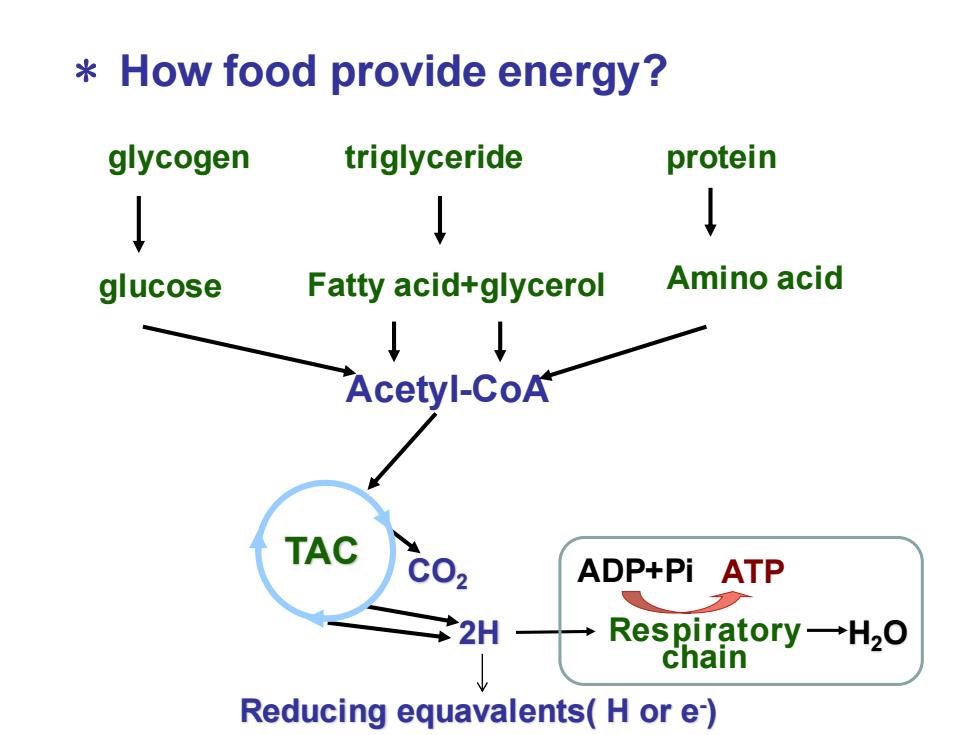
How food provide energy? glycogen triglyceride protein ↓ ↓ glucose Fatty acid+glycerol Amino acid ↓↓ Acetyl-CoA TAC C02 ADP+Pi ATP 2H Respiratory→H2O chain Reducing equavalents(H or e)
glycogen triglyceride protein glucose Fatty acid+glycerol Amino acid Acetyl-CoA TAC 2H Reducing equavalents( H or e- ) Respiratory chain H2O CO ADP+Pi ATP 2 * How food provide energy?
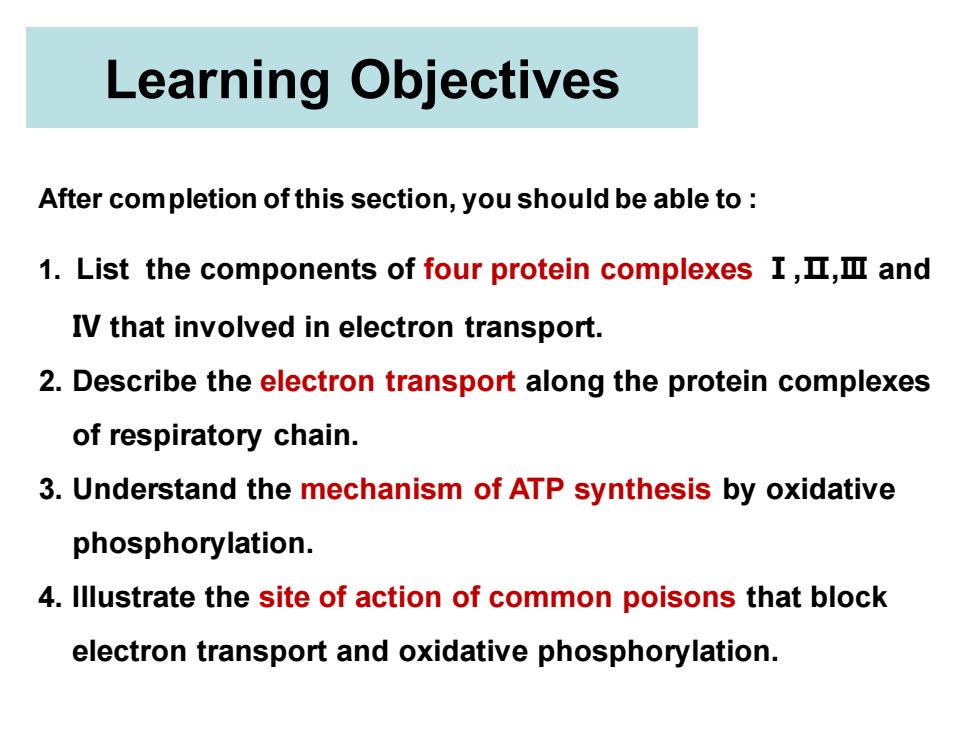
Learning Objectives After completion of this section,you should be able to 1.List the components of four protein complexes I,,and IV that involved in electron transport. 2.Describe the electron transport along the protein complexes of respiratory chain. 3.Understand the mechanism of ATP synthesis by oxidative phosphorylation. 4.Illustrate the site of action of common poisons that block electron transport and oxidative phosphorylation
Learning Objectives After completion of this section, you should be able to : 1. List the components of four protein complexes Ⅰ,Ⅱ,Ⅲ and Ⅳ that involved in electron transport. 2. Describe the electron transport along the protein complexes of respiratory chain. 3. Understand the mechanism of ATP synthesis by oxidative phosphorylation. 4. Illustrate the site of action of common poisons that block electron transport and oxidative phosphorylation
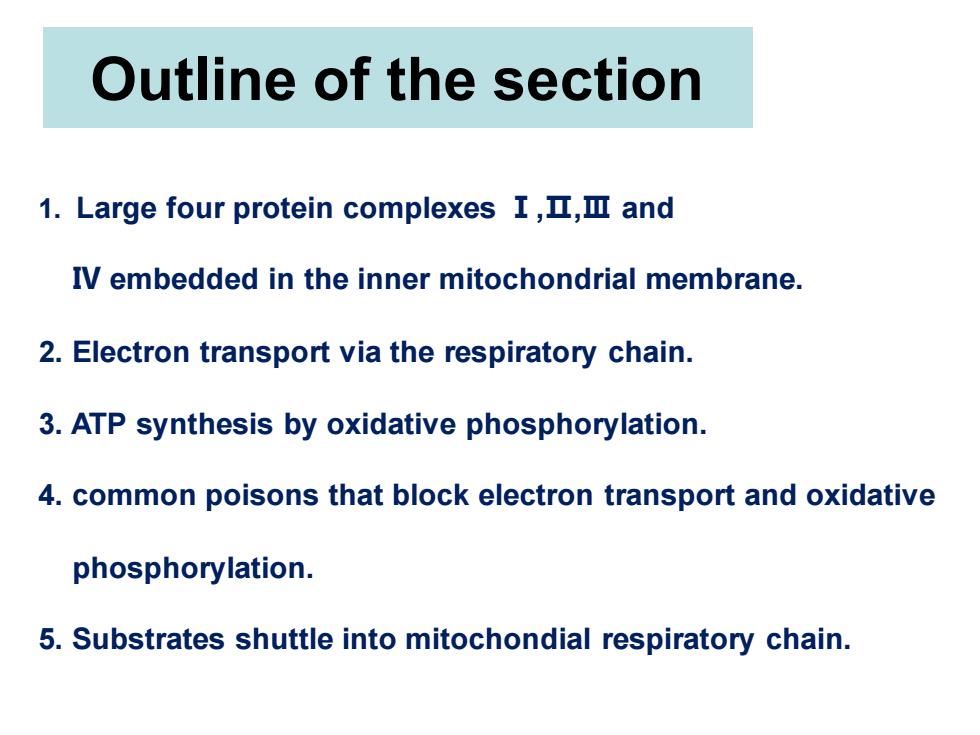
Outline of the section 1.Large four protein complexes I,,and IV embedded in the inner mitochondrial membrane. 2.Electron transport via the respiratory chain. 3.ATP synthesis by oxidative phosphorylation. 4.common poisons that block electron transport and oxidative phosphorylation. 5.Substrates shuttle into mitochondial respiratory chain
Outline of the section 1. Large four protein complexes Ⅰ,Ⅱ,Ⅲ and Ⅳ embedded in the inner mitochondrial membrane. 2. Electron transport via the respiratory chain. 3. ATP synthesis by oxidative phosphorylation. 4. common poisons that block electron transport and oxidative phosphorylation. 5. Substrates shuttle into mitochondial respiratory chain

Section 1 Large four protein complexes I,I,and IV embedded in the inner mitochondrial membrane
Section 1 Large four protein complexes Ⅰ,Ⅱ,Ⅲ and Ⅳ embedded in the inner mitochondrial membrane
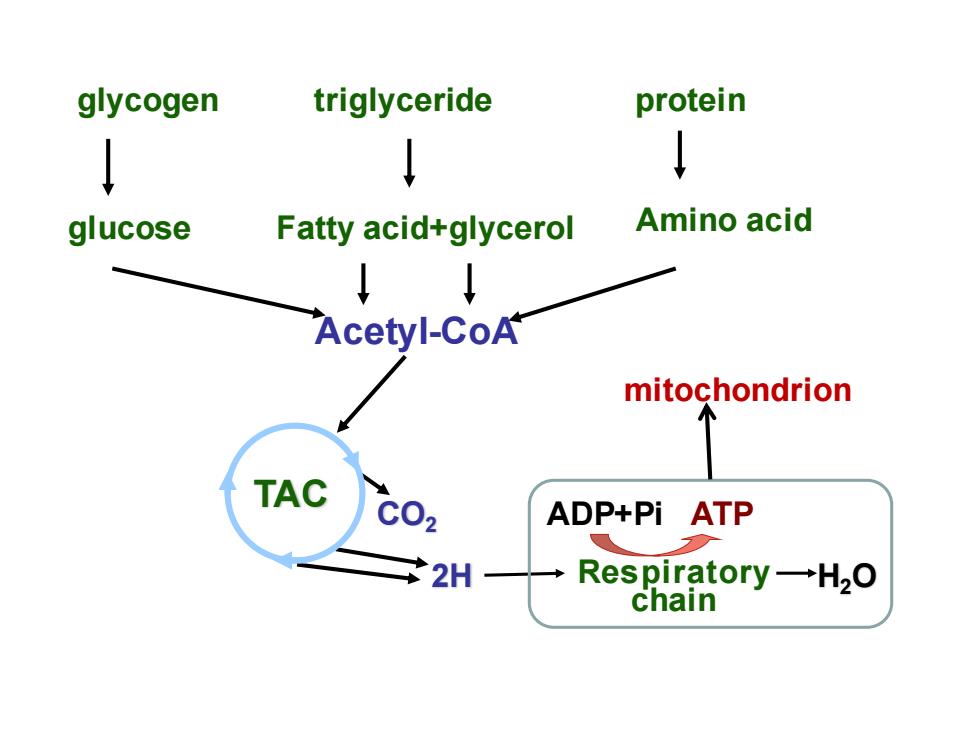
glycogen triglyceride protein ↓ glucose Fatty acid+glycerol Amino acid ↓↓ Acetyl-CoA mitochondrion TAC c02 ADP+Pi ATP 2H Respiratory→H2o chain
glycogen triglyceride protein glucose Fatty acid+glycerol Amino acid Acetyl-CoA TAC CO2 2H Respiratory chain H2O ADP+Pi ATP mitochondrion
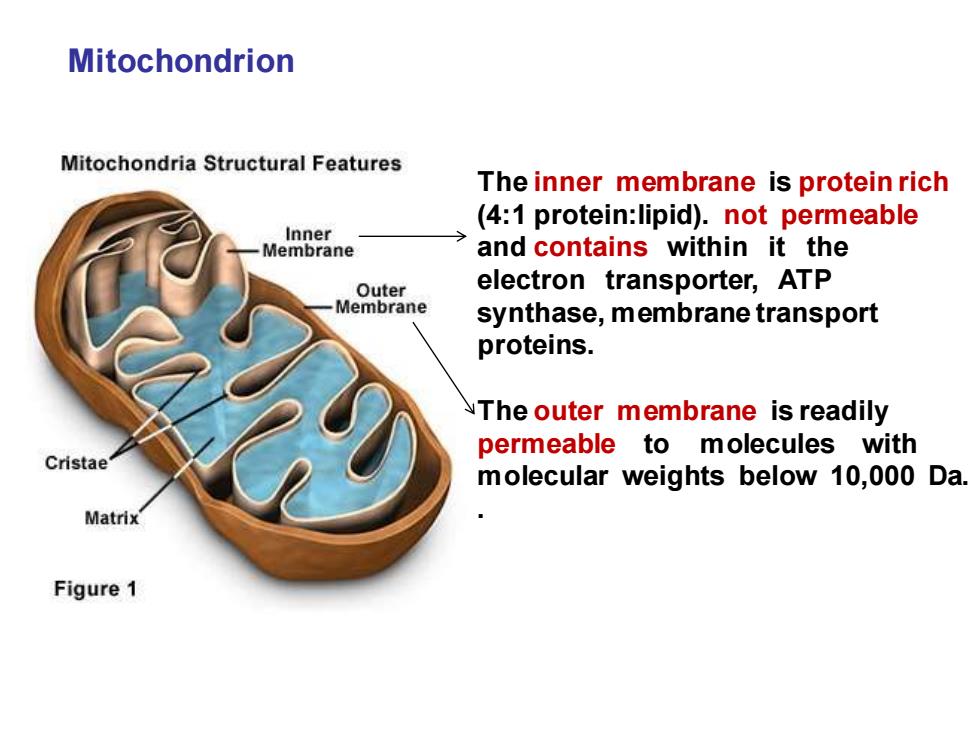
Mitochondrion Mitochondria Structural Features The inner membrane is protein rich (4:1 protein:lipid).not permeable Inner > Membrane and contains within it the Outer electron transporter,ATP Membrane synthase,membrane transport proteins. NThe outer membrane is readily permeable to molecules with Cristae molecular weights below 10,000 Da. Matrix Figure 1
Mitochondrion The inner membrane is protein rich (4:1 protein:lipid). not permeable and contains within it the electron transporter, ATP synthase, membrane transport proteins. The outer membrane is readily permeable to molecules with molecular weights below 10,000 Da.
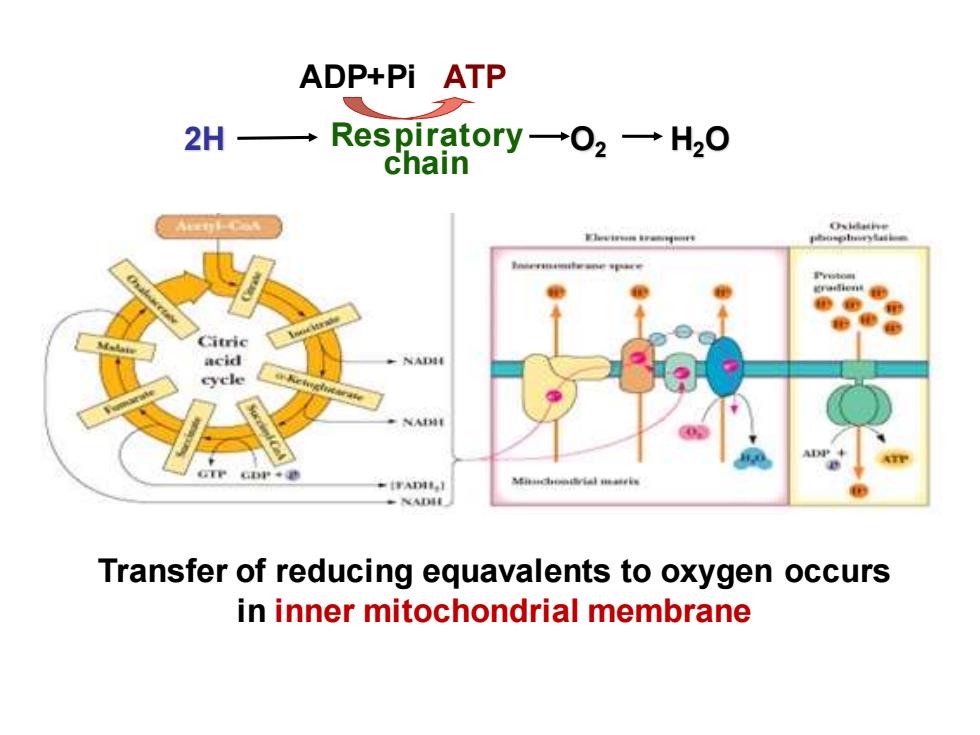
ADP+Pi ATP 2H→Respiratory→O2→H2O chain AERL-COA acid cyele NA NEinaecdoityrial meaneks -NADH Transfer of reducing equavalents to oxygen occurs in inner mitochondrial membrane
2H Respiratory chain O2 H2O ADP+Pi ATP Transfer of reducing equavalents to oxygen occurs in inner mitochondrial membrane
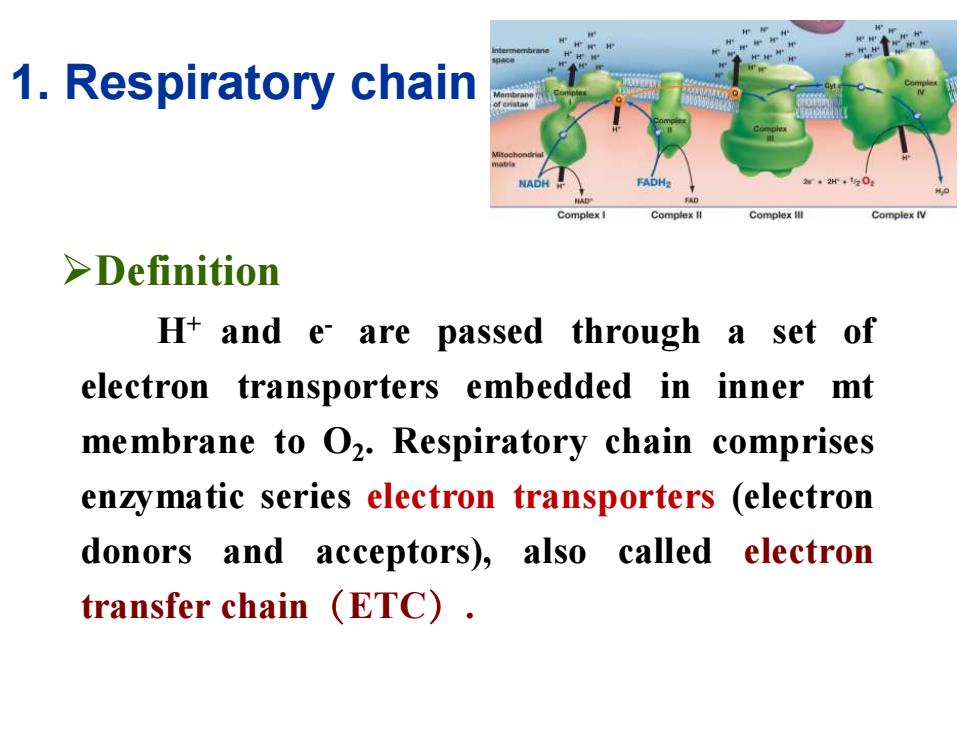
1.Respiratory chain NADH 。2H Comple Complex Complex IV >Definition H+and e are passed through a set of electron transporters embedded in inner mt membrane to O2.Respiratory chain comprises enzymatic series electron transporters (electron donors and acceptors),also called electron transfer chain (ETC)
➢Definition H+ and e - are passed through a set of electron transporters embedded in inner mt membrane to O2 . Respiratory chain comprises enzymatic series electron transporters (electron donors and acceptors), also called electron transfer chain(ETC). 1. Respiratory chain
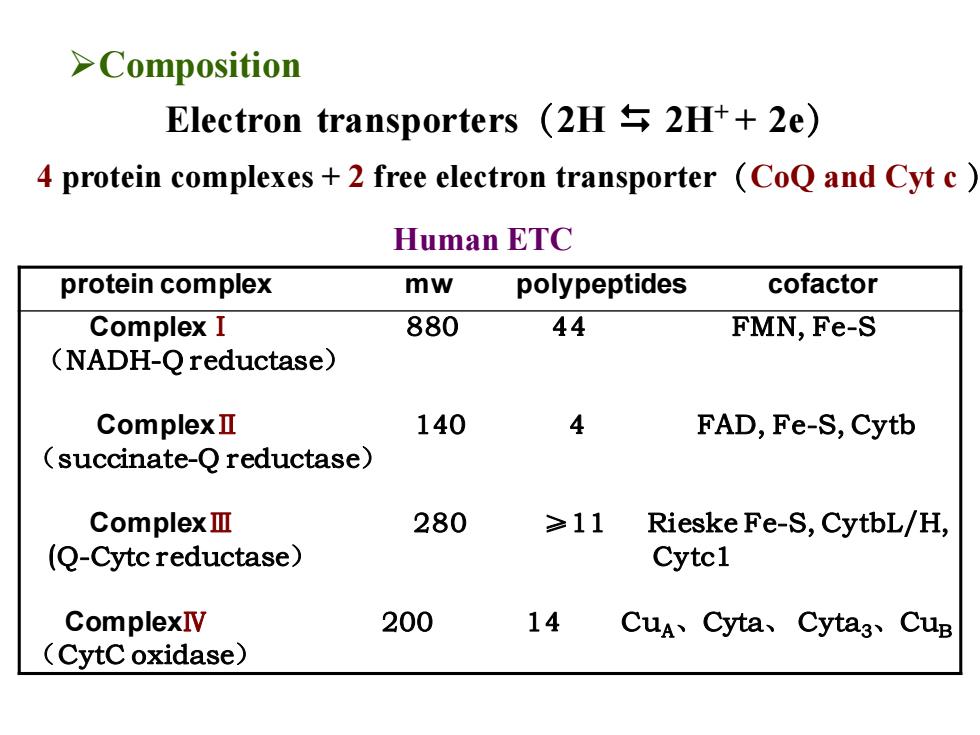
>Composition Electron transporters (2H 2H++2e) 4 protein complexes +2 free electron transporter (CoQ and Cyt c) Human ETC protein complex mw polypeptides cofactor Complex I 880 44 FMN,Fe-S (NADH-Q reductase) ComplexII 140 4 FAD,Fe-S,Cytb (succinate-Q reductase) ComplexⅢ 280 ≥11 Rieske Fe-S,CytbL/H, (Q-Cytc reductase) Cytc1 ComplexIV 200 14 Cua、Cyta、Cyta3Cug (CytC oxidase)
4 protein complexes + 2 free electron transporter(CoQ and Cyt c ) Human ETC protein complex mw polypeptides cofactor ComplexⅠ 880 44 FMN, Fe-S (NADH-Q reductase) ComplexⅡ 140 4 FAD, Fe-S, Cytb (succinate-Q reductase) ComplexⅢ 280 ≥11 Rieske Fe-S, CytbL/H, (Q-Cytc reductase) Cytc1 ComplexⅣ 200 14 CuA、Cyta、 Cyta3、CuB (CytC oxidase) ➢Composition Electron transporters(2H 2H+ + 2e)
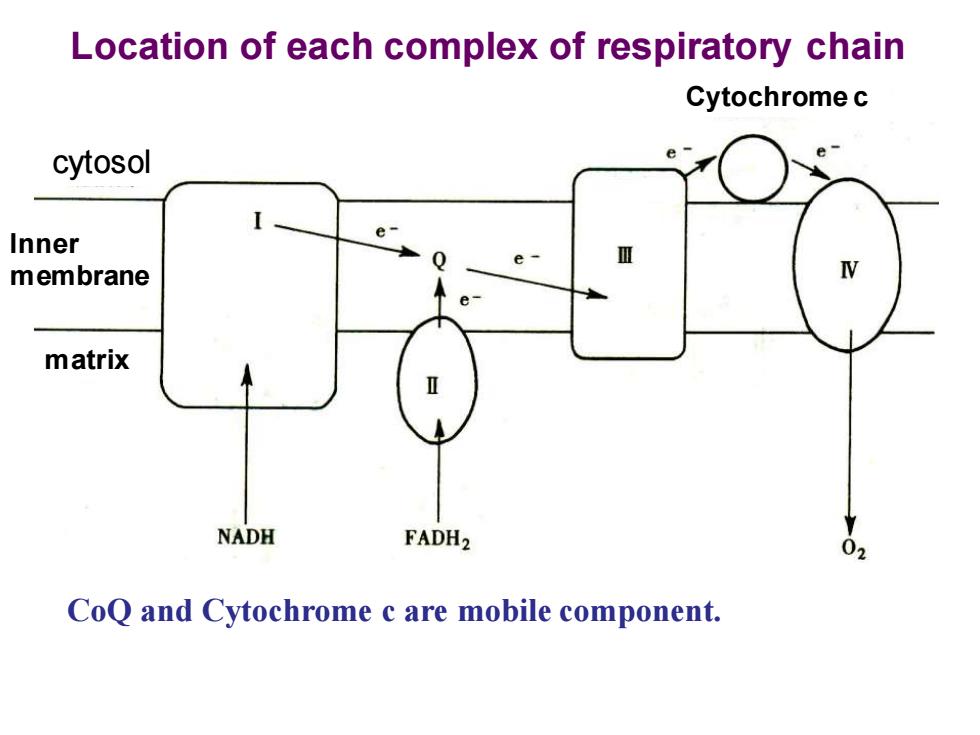
Location of each complex of respiratory chain Cytochrome c cytosol Inner membrane matrix NADH FADH2 09 CoQ and Cytochrome c are mobile component
Location of each complex of respiratory chain cytosol matrix Cytochrome c Inner membrane CoQ and Cytochrome c are mobile component